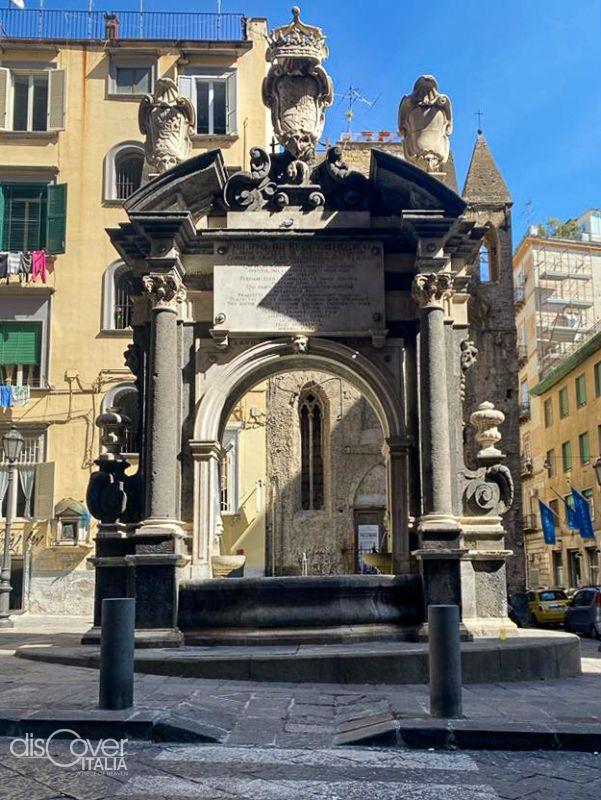Once upon a time, in the center of Naples, in the Pendino district, there was a square renowned for the production of saddles and harnesses for horses.
 It was precisely from this activity that it took its name Piazza della Sellaria or Selleria. Nearby there was also the famous Rua Toscana, where the warehouses of the Tuscan merchants who operated in Naples were located. In that square, there were various homes owned by a chief jailer of the Vicaria, who had been elected by the people during the very short period of life of the Neapolitan Republic of Masaniello, in the summer of 1647. Thus, the restoration of viceregal power over the city, during the reign of Philip IV, as had already happened in other places in Naples linked to the popular revolt, the Spanish revenge took the form of the demolition of the rebel's homes. In their place, by will of the viceroy Iñigo Vèlez de Guevara, Duke of Oñate, a monumental fountain was built to celebrate the restoration of Spanish power. The work was designed by the architect Onofrio Antonio Gisolfi and built between 1649 and 1652 by the marble worker Onofrio Calvano, the master builder Leonardo De Mayo, the blacksmith Salvatore Daniele and the stonemason Domenico Pacifico. The construction costs fell on the neighborhood homeowners.
It was precisely from this activity that it took its name Piazza della Sellaria or Selleria. Nearby there was also the famous Rua Toscana, where the warehouses of the Tuscan merchants who operated in Naples were located. In that square, there were various homes owned by a chief jailer of the Vicaria, who had been elected by the people during the very short period of life of the Neapolitan Republic of Masaniello, in the summer of 1647. Thus, the restoration of viceregal power over the city, during the reign of Philip IV, as had already happened in other places in Naples linked to the popular revolt, the Spanish revenge took the form of the demolition of the rebel's homes. In their place, by will of the viceroy Iñigo Vèlez de Guevara, Duke of Oñate, a monumental fountain was built to celebrate the restoration of Spanish power. The work was designed by the architect Onofrio Antonio Gisolfi and built between 1649 and 1652 by the marble worker Onofrio Calvano, the master builder Leonardo De Mayo, the blacksmith Salvatore Daniele and the stonemason Domenico Pacifico. The construction costs fell on the neighborhood homeowners.
During the excavation of the foundations, the section of the walls of the Greek city that passed through that point came to light, close to the area then occupied by the Circus Maximus and the gymnasium.
The new fountain, in Baroque style, was made of bricks, piperno and Carrara marble. A polygonal basin in piperno and white marble is inserted between two piers that support a round arch; on the sides there are two basins embellished with two masks with relative fountains. Two lateral columns with capitals in composite style support the top entablature, surmounted by a broken gable, which bears a composition of coats of arms in a central position: in the center stands the royal coat of arms of the Spanish Habsburgs, on the sides those of the viceroy Guevara, accompanied by the famous motto "Malo mori quam foedari (I prefer death to dishonor)", and of the city of Naples. Also on the sides, two volutes adorn a pair of cups, what remains of the original four. On the façades over the arch, two white marble plaques stand out with inscriptions from different eras: one commissioned by the viceroy, the other placed when the fountain was moved to its new location.
Yes, because the fountain is no longer in its original location. The Sellaria square, in fact, was among the ancient parts of the city that were sacrificed during the urban Redevelopment decided, following the devastating cholera epidemic of 1884, by the city government led by mayor Nicola Amore. The operation was started in 1889 and completely changed the face of the area of the ancient square. In place of the original one, another one arose, much larger and surrounded by four imposing buildings in neo-Renaissance style. The "four palaces" therefore became the popular name for the new space, which officially took the name of Piazza Nicola Amore.
On the occasion of the reorganization, the Sellaria fountain was moved to the piazzetta del Grande Archivio, between the ancient monastery of Saints Severino and Sossio, which became the seat of the State Archives of Naples, and the small ruined church of Santa Maria a Mare. It was 1903 and that move, which completely changed the layout of the lagoon, was celebrated by the marble epigraph which transmits its memory to posterity.



Comments powered by CComment